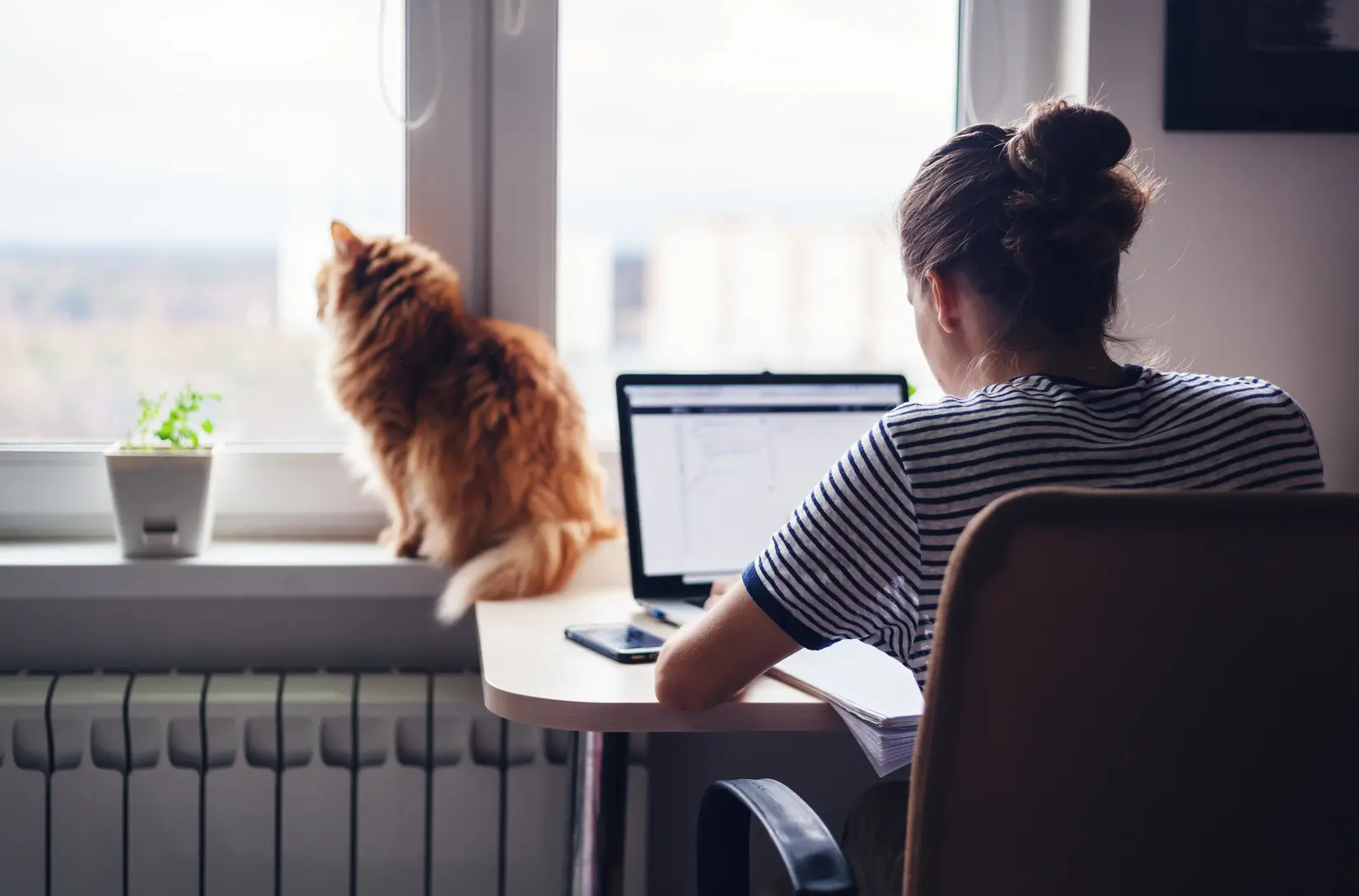
Are you a freelancer looking to boost your productivity while working from home? Creating a productive home office space is key! In this article, we’ll provide you with practical tips on choosing the right location, assessing your space and layout, creating a comfortable workstation, setting up proper lighting, organizing your office supplies, utilizing technology and productivity tools, establishing daily routines and schedules, managing noise and interruptions, and maintaining a healthy work-life balance. Let’s get started!
Choosing the Right Location
You should choose a location that suits your specific needs and preferences when setting up your productive home office space. The right location can greatly impact your productivity and overall work experience. Start by considering the amount of natural light you prefer. If you thrive in a bright and sunny environment, choose a room with large windows or set up your workspace near a window. On the other hand, if you prefer a more subdued lighting, select a room with adjustable blinds or curtains to control the amount of sunlight entering the space.
Another factor to consider is noise level. If you need a quiet environment to concentrate, choose a room that is away from high-traffic areas or noisy distractions. Alternatively, if you work better with some background noise, you can set up your office space near the living room or a room with a television or radio.
 Additionally, take into account the size of the space you require. If you need ample room for equipment or storage, choose a larger room or consider investing in office furniture that maximizes storage space. On the other hand, if you only require a small desk and minimal equipment, a smaller room or even a nook in your living room could suffice.
Additionally, take into account the size of the space you require. If you need ample room for equipment or storage, choose a larger room or consider investing in office furniture that maximizes storage space. On the other hand, if you only require a small desk and minimal equipment, a smaller room or even a nook in your living room could suffice.
Assessing Your Space and Layout
Take a look at your available space and consider how you can optimize it for maximum productivity. When assessing your space and layout for your home office, there are a few key factors to consider. First, ensure that you have enough room to comfortably fit all of your necessary equipment and supplies. This includes your desk, chair, computer, printer, and any other tools you may need for your work. It’s important to have enough space to move around and not feel cramped or restricted.
Next, think about the layout of your workspace. Consider the placement of your desk and chair in relation to windows and natural light. Natural light can boost your mood and energy levels, so try to position your desk near a window if possible. Additionally, consider the location of electrical outlets for easy access to power your devices.
 Another important aspect of your workspace layout is organization. Keep your desk clear of clutter and have designated spaces for important documents and supplies. Invest in storage solutions such as shelves, filing cabinets, or desk organizers to keep everything in order.
Another important aspect of your workspace layout is organization. Keep your desk clear of clutter and have designated spaces for important documents and supplies. Invest in storage solutions such as shelves, filing cabinets, or desk organizers to keep everything in order.
Lastly, think about the overall ambiance of your workspace. Consider adding plants, artwork, or other decorative elements that inspire creativity and motivation. Creating a comfortable and aesthetically pleasing environment can contribute to your overall productivity and well-being.
Creating a Comfortable Workstation
Once you have assessed your space and layout, it’s important to create a comfortable workstation where you can focus and be productive. Start by choosing a chair that provides proper support for your back and encourages good posture. Look for one that is adjustable in height and has cushioning for maximum comfort. Position your chair at a height that allows your feet to rest flat on the floor, and make sure your knees are at a 90-degree angle.
Next, consider your desk setup. Opt for a desk that is spacious enough to accommodate your computer, paperwork, and any other necessary equipment. It should be at a height that allows your arms to rest comfortably on the surface, with your elbows bent at a 90-degree angle. Keep your desk clutter-free and organized, as a clean workspace can promote better focus and productivity.
In addition to the chair and desk, invest in proper lighting for your workstation. Natural light is ideal, so try to position your desk near a window. If that’s not possible, use a combination of overhead and task lighting to ensure that your workspace is well-lit and easy on the eyes.
Lastly, personalize your workstation with items that inspire and motivate you. Whether it’s a favorite quote, a plant, or a family photo, having these personal touches can create a sense of comfort and make your workspace feel more inviting.
Setting Up Proper Lighting
To ensure optimal visibility and reduce eye strain, it’s important to properly set up lighting to create a productive home office space. Here are four tips to help you create a well-lit workspace:
- Natural Light: Position your desk near a window to take advantage of natural light. Natural light not only brightens up the space but also provides a sense of connection to the outdoors, boosting your mood and productivity.
- Task Lighting: Invest in a good desk lamp that provides adequate lighting for your work tasks. Choose a lamp with adjustable brightness levels and direction to suit your needs. Position it so that it illuminates your work area without causing glare on your computer screen.
- Ambient Lighting: Use overhead or ceiling lights to provide overall illumination in the room. Opt for warm or cool white bulbs depending on your preference and the type of work you do.
- Lighting Controls: Install dimmer switches or use smart lighting systems to control the intensity of your lights. This allows you to adjust the lighting levels according to the time of day and your specific needs, creating a comfortable and productive environment.
Organizing Your Office Supplies
Make sure you have a designated storage area for your essential office supplies to keep your workspace organized and efficient. Having a well-organized office space not only helps you find what you need quickly, but it also promotes productivity and reduces stress. To help you get started, here is a table showcasing some common office supplies and their recommended storage solutions:
| Office Supply | Recommended Storage Solution |
| Pens and pencils | Desk organizer or pencil case |
| Sticky notes | Memo board or sticky note dispenser |
| Paper clips | Drawer organizers or magnetic holders |
| Stapler | Desk drawer or stapler caddy |
| Scissors | Scissor holder or desk caddy |
Implementing Effective Storage Solutions
By utilizing efficient storage solutions and coordinating your office supplies, you can create a well-organized and productive home office space. Implementing effective storage solutions is essential for keeping your workspace clutter-free and maximizing your productivity. Here are four tips to help you create an efficient storage system:
- Invest in storage containers: Use containers to keep small items like pens, paper clips, and sticky notes organized. Clear containers are ideal as they allow you to easily see what’s inside.
- Utilize vertical space: Make use of wall shelves, hanging organizers, and file holders to maximize vertical storage. This will free up desk space and keep your important documents within reach.
- Label everything: Labels are a lifesaver when it comes to finding things quickly. Use labels on storage bins, folders, and shelves to easily identify what goes where.
- Implement a filing system: Establish a filing system for your documents and paperwork. Use file folders, binders, or digital folders to categorize and store important files. This will save you time and reduce stress when you need to find something.
Incorporating Ergonomic Furniture
Ensure your comfort and well-being by incorporating ergonomic furniture into your home office space. Ergonomic furniture is designed to provide maximum support and minimize strain on your body, allowing you to work for longer periods without discomfort. Here are some essential pieces of ergonomic furniture to consider:
| Furniture | Benefits |
| Ergonomic Chair | Provides proper lumbar support and adjustable height, ensuring proper posture and reducing the risk of back pain. |
| Adjustable Desk | Allows you to switch between sitting and standing positions, promoting better blood circulation and reducing the risk of musculoskeletal disorders. |
| Keyboard Tray | Keeps your keyboard at a comfortable height and angle, preventing wrist and shoulder strain. |
| Monitor Stand | Elevates your monitor to eye level, reducing neck and eye strain caused by looking down for extended periods. |
Designing a Distraction-Free Zone
To maximize your focus and productivity, regularly declutter and organize your home office space. A distraction-free zone is essential for maintaining a productive work environment. Here are four tips to help you design a space that minimizes distractions:
- Remove unnecessary items: Start by getting rid of any items that are not essential to your work. Clutter can be a major distraction, so keep only the items you need within reach.
- Create a designated workspace: Set aside a specific area in your home that is solely dedicated to your work. This will help you mentally separate your work life from your personal life and minimize distractions from other household activities.
- Minimize visual distractions: Keep your workspace clean and free of any visually stimulating elements. Avoid hanging up too many pictures or decorations that may divert your attention away from your work.
- Control noise levels: Identify any sources of noise in your home and find ways to minimize them. Consider using noise-cancelling headphones or playing soft background music to drown out any distracting sounds.
Personalizing Your Workspace
Make sure to add personal touches to your workspace to create a comfortable and inspiring environment. Personalizing your workspace not only adds a touch of your own personality, but it can also boost your mood and productivity. Here are some ideas to help you personalize your workspace:
| Personal Touches | Benefits |
| Family Photos | Reminds you of loved ones and brings a sense of comfort. |
| Inspirational Quotes | Motivates and inspires you throughout the day. |
| Plants | Adds a touch of nature and improves air quality. |
| Artwork or Posters | Enhances creativity and adds visual interest. |
| Favorite Colors | Choose colors that make you feel calm and focused. |
| Music | Create a playlist that helps you stay productive and focused. |
These are just a few examples, but feel free to think outside the box and add personal items that bring you joy and comfort. Remember, the goal is to create a space that reflects your unique style and preferences. By personalizing your workspace, you will create an environment that you enjoy spending time in, which will ultimately enhance your productivity and overall work experience.
Utilizing Technology and Home Office Productivity Tools
Maximize your productivity by integrating technology and using various productivity tools. In today’s digital age, there are countless tools and technologies available to help you stay organized and efficient in your home office. Here are four essential tools you should consider incorporating into your workflow:
- Task Management Apps: Keep track of your to-do lists and deadlines with the help of task management apps like Todoist or Trello. These apps allow you to create tasks, set due dates, and even collaborate with others, ensuring that you stay on top of your work and never miss a deadline.
- Communication Tools: Stay connected with clients and colleagues through communication tools like Slack or Microsoft Teams. These platforms provide instant messaging, video conferencing, and file sharing capabilities, making it easy to collaborate and communicate effectively with your team, no matter where they are located.
- Time Tracking Software: Keep track of your billable hours and manage your time effectively with time tracking software like Toggl or Harvest. These tools allow you to monitor how much time you spend on each task, helping you identify areas where you can improve efficiency and maximize your productivity.
- Cloud Storage Solutions: Store and access your files from anywhere with cloud storage solutions like Google Drive or Dropbox. These platforms offer secure and reliable storage for your documents, allowing you to access them on any device, collaborate with others, and ensure that your valuable work is always backed up.
Establishing Daily Routines and Schedules
Start your day off right by establishing a consistent daily routine and schedule for your home office work. Having a set routine can help you maintain focus, stay organized, and increase productivity. Here is a sample daily schedule to help you get started:
| Time | Activity | Details |
| 8:00 AM | Morning Routine | Get dressed, have breakfast, and exercise |
| 9:00 AM | Start Work | Check emails, prioritize tasks |
| 10:30 AM | Focused Work | Work on important projects or deadlines |
| 12:00 PM | Lunch Break | Take a break, have a healthy meal |
| 1:00 PM | Afternoon Tasks | Attend meetings, answer calls |
| 3:00 PM | Break and Refresh | Take a short walk or engage in a hobby |
| 3:30 PM | Wrap up Day | Finish pending tasks, plan for tomorrow |
| 5:00 PM | End Work | Shut down your computer and tidy up |
Managing Noise and Interruptions in Your Home Office
To maintain focus and productivity in your home office, be proactive in managing noise and interruptions. Here are four tips to help you create a peaceful and distraction-free work environment:
- Set boundaries with your family and friends: Communicate your work schedule and let them know when you can and cannot be disturbed. Ask for their support in minimizing noise and interruptions during your working hours.
- Use noise-cancelling headphones: Invest in a good pair of noise-cancelling headphones to block out external sounds. They can help you concentrate on your tasks and reduce distractions caused by background noise.
- Designate a quiet workspace: Choose a dedicated area in your home where you can work without disturbances. Ideally, it should be a separate room with a door that can be closed, but if that’s not possible, create a designated space in a quiet corner of your home.
- Establish quiet hours: If you live with others, establish specific quiet hours when everyone in the house should keep noise to a minimum. This will help create a peaceful environment during your work hours and allow you to focus without interruptions.
Maintaining a Healthy Work-Life Balance
You can achieve a healthy work-life balance by setting boundaries and prioritizing self-care in your freelance career. As a freelancer, it can be tempting to work around the clock, especially when your office is just a few steps away. However, it is important to establish clear boundaries between your work and personal life to avoid burnout and maintain overall well-being.
One effective way to set boundaries is by creating a designated workspace in your home. This can be a separate room or a specific area where you can focus solely on work. When you step into this space, you switch into work mode, and when you step out, you switch into personal mode. This physical separation can help you mentally disconnect from work and maintain a healthier work-life balance.
Additionally, it is essential to prioritize self-care. This means taking breaks, exercising regularly, eating well, and getting enough sleep. By taking care of your physical and mental health, you will be more productive during your work hours and have more energy to enjoy your personal life.
Furthermore, consider establishing a schedule that includes dedicated time for both work and personal activities. Set specific working hours and stick to them as much as possible. This will prevent work from spilling over into your personal time and vice versa. As a freelancer you should check seopress vs rankmath.
Frequently Asked Questions
How Can I Manage Distractions and Interruptions While Working From Home?
You can manage distractions and interruptions while working from home by creating a designated workspace, setting boundaries with family members, using noise-canceling headphones, and turning off notifications on your phone.
What Are Some Effective Ways to Personalize My Home Office Space?
To personalize your home office space, consider adding items that inspire you, such as artwork or motivational quotes. Don’t forget to make it comfortable with a cozy chair and proper lighting.
Are There Any Specific Technology or Productivity Tools That Can Enhance My Work-From-Home Experience?
There are many technology and productivity tools that can enhance your work-from-home experience. From project management software to noise-canceling headphones, these tools can help you stay organized and focused on your work.
What Are Some Tips for Establishing Daily Routines and Schedules When Working as a Freelancer?
Set clear daily routines and schedules as a freelancer. Prioritize tasks, allocate dedicated work hours, and take regular breaks. Create a productive environment, establish boundaries, and stick to a consistent routine to stay focused and motivated.
How Can I Maintain a Healthy Work-Life Balance While Working From Home?
To maintain a healthy work-life balance while working from home, prioritize self-care, set clear boundaries between work and personal life, and schedule regular breaks. Remember, it’s important to take time for yourself and avoid burnout.
Conclusion
In conclusion, by following these tips for creating a productive home office space, freelancers can optimize their work environment and improve their overall productivity. Choosing the right location, assessing the space and layout, creating a comfortable workstation, setting up proper lighting, organizing office supplies, utilizing technology and productivity tools, establishing daily routines, managing noise and interruptions, and maintaining a healthy work-life balance are all essential factors in creating a successful home office.
506 Views














